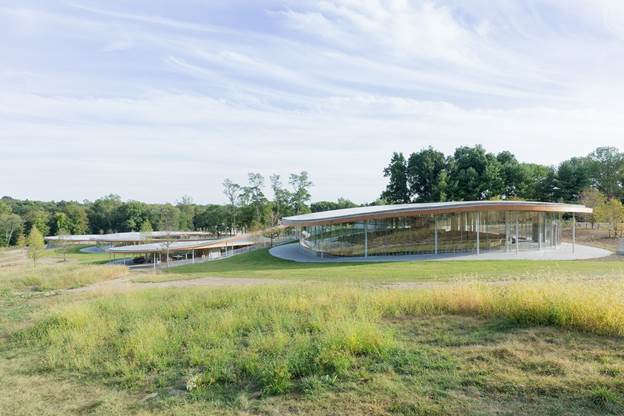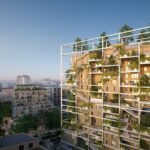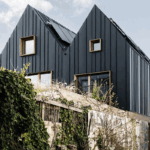UN Climate Change Conference in Paris, COP 21 building design architects
UN Climate Change Conference in Paris
COP 21 Architecture, France: Global Eco Building Design.
Paris Climate Change Agreement
Information from LDA Design (Oxford):
14 Dec 2015
UN Paris Climate Change Agreement
This weekend’s Paris Agreement represents a historic moment in the fight against climate change. An enduring, legally-binding treaty, it is the first to commit all countries to cutting carbon emissions. 187 countries will reduce carbon emissions, starting in 2020, once 55 countries covering 55% of global emissions have acceded to it.
Two weeks of intense negotiations at the COP21 summit has led to:
• A set of decisions with immediate effect to accelerate climate action and to prepare for the implementation of the Paris Agreement once it enters into force
• A significant number of separate and additional actions to mitigate and adapt to climate change made by countries, regions, cities, investors and companies
In addition to national governments, COP21 also brought together businesses, cities and civil society, creating an irresistible sense of momentum towards action on climate change. The spirit of cooperation and shared endeavour that we have seen in Paris will be critical in addressing the challenges that we all face in future.
The outcomes from Paris provide a clear trajectory towards a low carbon global economy. The writing is now clearly on the wall for fossil fuels, starting with the most carbon intensive, and ultimately affecting all fossil fuels. Business as usual will no longer make economic sense. Investors, developers, infrastructure providers and other decision-makers who ignore this will risk losses, stranded assets and development that is not fit for purpose.
The Paris Agreement will lead to trillions of pounds worth of investment across the world to both reduce carbon emissions and adapt to the changes in climate which are already inevitable. This represents and immense economic and business opportunity.
A broad range of measures will be needed, from low carbon energy supplies, efficient and resilient buildings, more sustainable transport modes and flood defences, to improvements in the way we manage the land, water and other resources. The Paris Agreement should give confidence to investors, developers and infrastructure providers who are geared up to meet these needs that they are doing the right thing financially as well as environmentally.
Unfortunately the UK government has been steadily dismantling mechanisms designed to support the transition to a low carbon economy, from reducing or removing subsidies for renewable energy technologies, to cutting energy efficiency programmes, to cancelling the competition to build a full-scale carbon capture and storage facility.
Importantly however, while we would urge a more ambitious and forward-thinking approach from government, there is much that can be done in the interim to make progress. For example, LDA Design is currently working with a number of our solar energy clients to move their business model towards one that isn’t reliant on subsidies by bringing together innovative combinations of generation, energy storage, distribution and demand.
14 Dec 2015
Climate Change Conference Paris Deal
Climate Change Talks in Paris
Information from Global Justice Now:
“For us people who are really affected by climate change, we need to change the (slogan) ‘1.5 to stay alive’ to ‘1.5 we might survive’, because already at 0.8 degrees, we’re already suffering loss of lives.”
Addressing a crowd at the climate talks protests in Paris, Lidy Nacpil from Jubilee South-Asia/Pacific added: “we will pay in the South in terms of millions of lives and millions of people displaced.”
Despite the state of emergency, the energy and enthusiasm were overwhelming. Now we need to support the many struggles for a better world over the next year and turn this energy into real change.
“Most of the progress we’ve made towards justice, democracy and peace have been a result of people coming together.” Global Justice Now supporter
Inside the climate talks – COP21, the 21st Conference of the Parties – things were less positive. Yes, we have a deal, and yes, it says world leaders will try to limit global warming to 1.5°C. But there are no means to actually achieve this. The collective reductions promised by world powers head us closer to a catastrophic 3°C. And even those reductions are not legally binding.
Worse still, rich countries used their supposed ambition to gut the deal of any sort of equity. The US and allies worked tirelessly to undermine the whole promise of climate talks up till now – that rich industrial countries are responsible for climate change and should take the lead in fighting it. Anything else means climate change can only be halted at the price of neverending poverty.
But we always knew that the same world leaders pushing industrial agriculture, supporting big fossil fuel businesses, and promoting free-trade agreements like TTIP, would be unable to halt climate change. That falls to campaigns and movements of ordinary people; people like you.
At Global Justice Now we believe that to really tackle climate change, we need to fundamentally change the way the global economy works. This change will not be made by corporations or world leaders. Rather, it will be made by us as a global movement of citizens.
In the months ahead we will build a stronger movement – to defeat TTIP, to support small-scale agriculture and to promote energy democracy, along with our allies across the world. This change in our economic system is at the centre of halting climate change.
source: Global Justice
13 Dec 2015
UN Climate Change Conference Paris Deal: COP 21
Deal at the UN Climate Change Conference in Paris
The climate deal reached in Paris is “the best chance we have to save the one planet we have”, US President Barack Obama has said, reports the BBC today.
He said it could be a “turning point” for the world to take on the challenge of a low-carbon future.
China, the world’s biggest polluter, also hailed the deal. But some campaigners said it did not go far enough to protect the planet.
The Paris pact aims to curb global warming to less than 2C (3.6F)
Building the Change – Official UNEP video from Buildings Day, COP21:
Global greenhouse gas emissions by economic sectors:
35% Energy production
18% Industrial production
14% Transport
14% Agriculture
10% Deforestation
6% Buildings
3% Waste and water treatment
In 2010, developed countries accounted for 36% of global greenhouse gas emissions (18% of the global population).
Their per capita greenhouse gas emissions averaged slightly less than three times
those of developing countries.
An architect’s view:
In Paris at COP21, Gensler Principal Rives Taylor explains how building design, construction and use impact climate change. Rives also notes how Paris’ historic architecture offers ideas for how to create lasting, energy efficient buildings. #COP21.
Published on 3 Dec 2015
5 + 4 Dec 2015
Buildings at UN Climate Change Conference Paris: COP 21
UN Climate Change Conference in Paris – COP 21 Buildings
Why Buildings?
More than 30 per cent of global greenhouse gas emissions are buildings-related, and emissions could double by 2050 if we carry on business as usual. Not changing increases risks and vulnerability of countries, regions and local communities from climate change. Rapid urbanization could accelerate impacts.
Yet:
The buildings sector offers one of the most cost-effective and economically beneficial paths for reducing energy demand and associated emissions while at the same time supporting adaptation and resilience to climate change.
Many low-energy, renewable and deep- renovation solutions are available. Proven policy, finance and technology actions exist.
The economic, health, and social benefits of sustainable buildings are significant. Buildings provide shelter, places to live, work, learn and socialize, directly affecting our daily lives. Providing more than 50 per cent of global wealth, and one of the largest employers at local level, the sector also offers a path to poverty alleviation.
Buildings are long-term ventures. Today’s new buildings are tomorrow’s existing stock. Failure to act now would lock in growth in GHG emissions for decades.
Website: COP 21 Paris Buildings
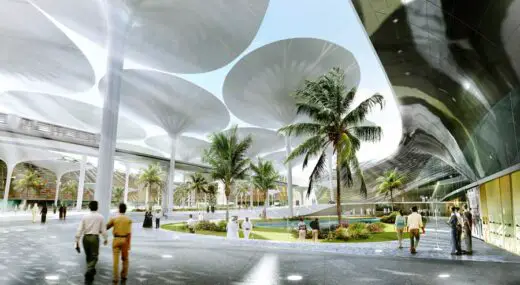
image : Lava’s design for Masdar City Abu Dhabi Competition – World’s first ‘zero carbon, zero waste city‘
UN Climate Change Conference in Paris – COP 21 Buildings Day
Thursday at COP21 was Buildings Day, and it was marked by the launch of the Global Alliance for Buildings and Construction, which aims to scale up the sector’s attempts to decarbonise, according to http://www.edie.net/.
Eighteen countries (Austria, Brazil, Cameroon, Canada, Finland, France, Germany, Indonesia, Japan, Mexico, Morocco, Norway, Senegal, Singapore, Sweden, Tunisia, Ukraine, United Arab Emirates, the US, and over 60 organizations are part of the alliance.
As an example of the type of action the coalition will take, the World Green Building Council (WGBC) committed to a ‘global market transformation’ to achieve two goals by 2050: net zero carbon new building and the energy efficiency retrofit of existing stock.
Website: COP 21 Paris Buildings Day
Sustainable Innovation Forum at COP 21
Forthcoming event at COP 21:
The Sustainable Innovation Forum (SIF15) is the largest business focused event held during the annual Conference of Parties (COP), taking place this year on 7- 8 December at COP21 at Stade de France (gate E) in Paris.
Website: COP 21 Paris
1 Dec 2015
UN Climate Change Conference Paris: COP 21
UN Climate Change Conference in Paris – COP 21
The UN and the governments of France and Peru have launched a new website to demonstrate how momentum for climate action is building ahead of the UN Climate Change Conference in Paris (COP 21), at which governments will conclude a new universal climate agreement, reports UNFCCC.
The website showcases the scope of this mobilization under the Lima-Paris Action Agenda (LPAA), which brings both state and non-state actors together on the global stage to accelerate cooperative climate action now and into the future in support of the new agreement.
Cooperative climate action is essential for the international community to keep the global average temperature rise below 2°C degrees, the internationally-agreed defense line against the worst impacts of climate change.
On this website more initiatives are being added and will be added as information is gathered from the many groups which have come together to take cohesive and concrete climate action.
The action areas covered are agriculture, forest, transport, renewable energy, energy access and efficiency, resilience, cities and sub-nationals, private finance, business, innovation, building and short-term pollutants.
The website complements the Non-State Actor Zone for Climate Action (NAZCA) launched last year at the UN climate change conference in Lima by the COP 20 Presidency of Peru together with the UN, which registers individual and cooperative commitments to action by companies, cities, subnational regions, and investors to address climate change.
Anyone who registers in NAZCA is also encouraged to join one of the many transformational initiatives under the Lima-Paris Action Agenda.
The Lima-Paris Action Agenda is a joint undertaking of the Peruvian and French COP Presidencies, the Executive Office of the Secretary-General of the United Nations and the UNFCCC Secretariat.
It is aimed at strengthening climate action now and beyond the Paris COP 21 conference in December by taking robust global action towards low-carbon, climate-resilient societies; encouraging action and commitments by non-state actors and providing enhanced support to existing initiatives such as those launched during the UN Secretary General’s Climate summit in September 2014; and mobilizing new partners and providing a platform for the visibility of their actions, commitments and results in the run up to COP21.
UIA president Esa Mohamed will participate in Buildings Day at COP21 on December 3
The aim of Buildings Day, organised by the United Nations Environnement Programme (UNEP) is to provide an opportunity to launch an alliance of organizations collectively committed to: helping to put the buildings and construction sector on the “below 2°C path”; aligning existing initiatives, commitments and programmes to achieve greater scale and increase the pace of efficiency actions; and catalysing stronger collaboration and targeting sectoral and cross sectoral climate action and solutions for all.
Soneva Kiri Resort in Thailand – responsive architecture using natural materials:
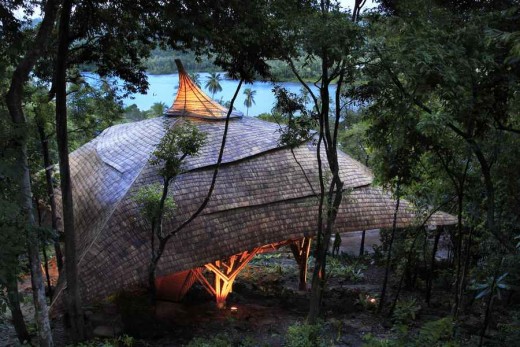
Manifesto for Responsible Architecture
MANIFESTO FOR RESPONSIBLE ARCHITECTURE – Architects’ commitment to address climate change
Ahead of the COP21 summit to be held in Paris from 30 November to 11 December, the Architects’ Council of Europe (ACE), the International Union of Architects (UIA), the National Council of the Order of French Architects (CNOA), and the International Council of French Architects (CIAF) have endorsed a Manifesto presenting Architects’ commitment to tackle the challenges posed by climate change.
This Manifesto will be officially presented and discussed during the international conference”Architecture, the Climate of the Future”, which will take place on 30 November 2015 in Paris at the Cité de l’Architecture et du Patrimoine, on the opening day of the UN Climate Change Conference (COP21).
The Manifesto consists of key recommendations to address climate change through the built environment, both at city and building levels. It recalls that Architecture is a powerful force, both in the medium term and at low-cost, for reducing greenhouse gas emissions and adapting our societies to the inevitable side effects of climate change.
Through this Manifesto, the four organisations, which represent the architectural profession at national, European and international levels, call for the implementation of decisive policies to stop the uncontrolled growth of cities, eradicate the injustice related to the allocation of resources, slow down the climate exodus, anticipate exposure to natural or industrial risks and to put an end to the depletion of natural resources across the planet.
Those wishing to sign the Manifesto will find it on the website of the CNOA: http://petition.architectes.org/
Speakers at the “Architecture, the Climate of the Future” conference include renowned architects (K.T. Thorsen, M. Hegger, P. Coulombel, A. Heringer, C. Smuts, P. Gontier, D. Mangin, K. Yeang, E. Mazria, F. Bonnet), but also scientists (S. Joussaume, T. Salomon) and French and EU policy-makers (F. Chouat, D. Ristori, C. Turmes, K. Delli).
Architecture, the climate of the future
COP21, International conference in Paris “Architecture, the climate of the future”
The international conference ‘Architecture the climate of the future’ -organized jointly by the UIA, the ACE, CNOA and CIAF, November 30, 2015 encountered a great success. The number of registered already exceeds the capacity of the auditorium!
However, it will be possible to follow the conference worldwide on the Internet.
The broadcast of the conference, on internet via Livestream platform, is scheduled November 30 from 2 p.m (Paris time).
As part of their ongoing commitment to responsible architecture, ever mindful of factors related to climate and the environment, the International Union of Architects (UIA), the Architects’ Council of Europe (ACE), the National Council of the Order of French Architects (CNOA), and the International Council of French Architects (CIAF) announce an international conference on the theme: Architecture, the climate of the future. The symposium will take place in Paris, at the Cité de l’architecture et du patrimoine, on 30 November 2015, from 2:00 pm until 7:30 pm. on the opening day of the UN Climate Change Conference: COP 21.
The conference is organised in two parts, starting at 2 o’clock with a panel discussion to examine the impact of buildings and planning on climate change, and the role architects play in energy transition. Panellists include architects Kjetil Traedal Thorsen, Manfred Hegger, Patrick Coulombel, Anna Heringer, Carin Smuts, Pascal Gontier and David Mangin, with Sylvie Joussaume, French climatologist.
A round-table will follow the panel presentations, at 5:30 pm, and will offer architects, scientists and political decision makers from France and around Europe to discuss the role of cities and buildings in the struggle against climate imbalances on two specific questions: How can cities be made resilient and sustainable? How can design become the determining factor for a building’s sustainability? Participants include architects Kenneth Yeang, Edward Mazria, Frederic Bonnet and Kjetil Traedal Thorsen, energy engineer Thierry Salomon, and European Parliament members Claude Turmes and Karima Delli.
All the participating architects have oriented their careers toward finding alternative architectural and building solutions that offer a significant reduction in the consumption of fossil fuels and the emission of greenhouse gases.
This event, a joint initiative by the institutions that represent the architectural profession internationally, will enjoy the participation of their respective presidents: Esa Mohamed, Luciano Lazzari, Ms. Catherine Jacquot, and Philippe Klein – and is realised as a co-production with the Cité de l’architecture et du patrimoine.
UN Climate Change Conference Paris – Links
Links:
http://web.unep.org/climatechange/buildingsday
http://www.uia.archi/en/participer/nouvelles/10223#.Vl2uCnbhBaQ
http://www.ace-cae.eu/22/?tx_ttnews%5BbackPid%5D=1&tx_ttnews%5Btt_news%5D=1302&cHash=199651fc61a38944f112f09f60995c2c
http://www.uia.archi/en/participer/nouvelles/9843#.Vl2tSHbhBaQ
Are we doing enough?
Sustainable Architecture – Building Issues
Discussion
Sustainable Buildings – summary below
This topic has become controversial and the phrase ‘sustainable’ and linked phrases, problematic. Initially sustainable architecture seemed to have a groundswell of support as the awareness and discussion of climate change gathered pace. But soon many mainstream suppliers, architects, contractors, etc. were using the phrase – and underlying philosophy – in a glib manner.
Naturally they quickly wanted to use the label as it seemed to send the right message, that they cared about the environment and were not part of the problem. But often the words were shallow attempts at window dressing and underneath many practices remained unsustainable.
Wadi Rum, Jordan : Oppenheim Architecture + Design
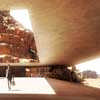
image from architect
Ray and Dagmar Dolby Regeneration Medicine Building, USA : Rafael Viñoly
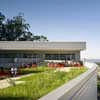
photo Courtesy Bruce Damonte
If you were to compare a specific supply of steel and aluminium, would the apparently ‘more sustainable’ aluminium be the winner when you witness the destruction of rainforest for the plant and access roads, the silting of the rivers from Bauxite extraction, removal of indigenous tribes from the area and massive pollution from driving trucks in and out of the deep jungle?
Initially sustainable architecture seemed to be about quite comprehendable issues such as using ‘natural’ energy eg solar power, lots of wood and high U values. But as the books and conferences have multiplied there are now a whole range of issues that architects are being asked to analyse.
Essentially there seem to be no simple comparisons for materials but there are various websites and specification guides that aim to assist, eg the Green Guide to Specifications (BRE) or NGS.
Example of sustainable architecture:
Soneva Kiri Resort, Thailand
Design: 24H > architecture
Sustainable Resort Buildings
Paris, France
New Paris Architecture
Contemporary Paris Architecture
Paris Building Designs – chronological list
Paris Architecture Tours by e-architect
Sustainable Architecture : main page
Sustainable Architecture – Selection
Sustainable Office Building : Scottish Natural Heritage HQ Building
Sun Ship Freiburg – Sonnenschiff, Freiburg im Breisgau, Baden-Württemberg, Germany
Sun Ship Freiburg
“Solar Architecture is not about fashion – it is about survival”
Lord Norman Foster
Sustainable Home Architecture : Lotte Glob House
Energy Island : Maritime Energy Generation Building
Sustainable Building in Scotland : David Douglas Centre
Sustainable Architecture Design : Article by Trevor Tucker
Sustainable Architecture News Scotland
Comments for the UN Climate Change Conference Paris: COP 21 Sustainable Buildings page welcome
Website: COP 21 Paris

